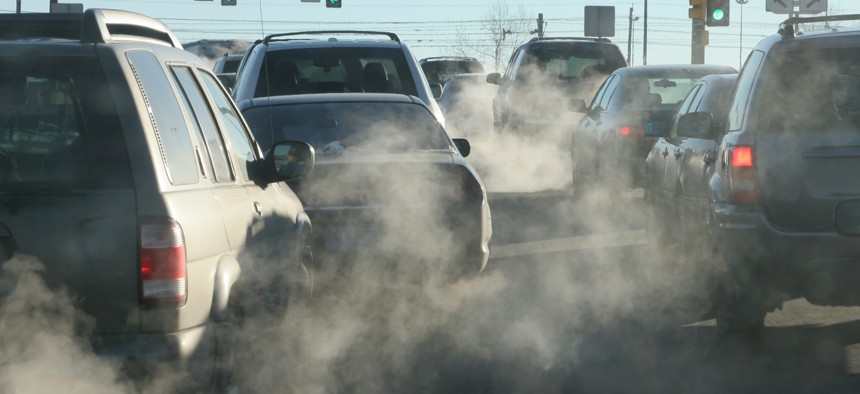Why California's Power to Regulate Auto Pollution Matters Nationwide

getty Images/milehightraveler
As the state regains the ability to set tailpipe standards stricter than the federal government's, it could have far-reaching effects.
California will once again be able to set its stricter rules than the federal government’s standards limiting air pollution from automobiles, according to several news reports. The question now is: How will California use its power?
The change restores California’s ability to set greenhouse gas pollution rules that are stricter than the federal government’s regulations. It would further solidify California’s traditional role as a leader in air pollution regulation and its recent posture as a leader in fighting climate change.
Gov. Gavin Newsom has already ordered California to stop selling cars and passenger trucks that burn fossil fuels by 2035, and this would go a long way to helping him achieve that goal.
Going forward, California’s rule-making authority could have far-reaching effects outside of its borders, too. It is the only state that can set its own standards, but other states can follow California’s lead if they choose. Seventeen states have adopted some or all of California’s air pollution rules for vehicles. More than 38% of all light-duty vehicles in the U.S. are sold in those states.
Automakers, which are rushing to ramp up production of electric vehicles, often prefer to have unified national vehicle standards, rather than ones for separate markets.
“President Biden is desperate to have an impact on climate change, and a clean cars policy is low-hanging fruit” to further that goal, said Scott Hochberg, a transportation attorney at the Center for Biological Diversity’s Climate Law Institute
The transportation sector produces more carbon dioxide pollution than any other part of the economy, including electric generation, and light-duty vehicles account for most of that pollution within the sector, he noted.
Status in Jeopardy
The Clean Air Act of 1970 first gave California special permission to regulate air pollution, which has long been a problem in the coastal state.
The Obama administration, which orchestrated a bailout of two major auto companies, struck a deal between the industry and California regulators that established nationwide emission standards. But the Trump administration rescinded that agreement and, for the first time, tried to revoke California’s authority to set air pollution standards for vehicles.
California, in turn, reached separate agreements with several automakers in which they recognized its regulatory authority and agreed to comply with limits that the state imposed.
Of course, when Biden took office, his administration started to undo many of Trump’s rules regarding vehicle pollution. It rescinded the policy that would have blocked California from applying for Clean Air Act waivers with the Environmental Protection Agency.
In December, the Biden administration also set stricter vehicle mileage standards for vehicles through model year 2026.
The next step for the administration would be to reinstate California’s ability to regulate through 2026. But California would have to apply for waivers from the EPA for rules that affect model years beyond that.
“Reinstating the waiver would be consistent with decades of policy under the Clean Air Act,” said Julia Stein, the project director of the Emmett Institute on Climate Change and the Environment at the University of California, Los Angeles. It would reverse the “unprecedented” act of rescinding California’s waiver from the Trump administration, she said.
But Stein added that both the Biden administration and California officials are planning for what happens after the 2026 rules expire.
“2026 seems far away, but automakers start making decisions about how they’re going to comply with those regulatory frameworks well in advance of those cars rolling onto the lots,” Stein said. “So that process is usually completed a couple years in advance of the model year.”
A More Aggressive Approach?
Hochberg said the only way Biden and Newsom can advance their climate goals with this action is if California sets aggressive rules for moving to zero-emission vehicles.
“Now that he’s [getting] the keys back, Gov. Newsom needs to steer California to the strongest possible clean car standard and reclaim the state’s climate leadership,” Hochberg said. The decision, he added, would “undo the damage from the Trump years, but it’s only meaningful if California uses its unique power to lead the nation with the deep emissions cuts the climate crisis demands.”
Specifically, Hochberg said that the California agency writing the next round of rules for vehicle emissions, which could be adopted as early as this summer, is not being aggressive enough.
In draft rules released in January, the California Air Resources Board is setting a target of requiring 61% of new vehicles sold in California to produce zero emissions by 2030. That’s only slightly better than the 50% target set nationally by the Biden administration, Hochberg noted. (Last year, 12.4% of new vehicles sold in California were zero-emission vehicles, compared to 1.7% nationally in 2020.)
“California is starting from a place of having many more [electric vehicles] on the road and many more chargers than the rest of the country,” Hochberg said in an interview. “It has no excuse for failing to move much faster.”
In supporting documentation for its rules, the Air Resources Board acknowledged that “slower deployments generally produced fewer benefits.” But it opted for less aggressive targets “due to feasibility concerns.”
Still, it said the “greater potential benefits” of a more rapid rollout “suggest a need to further review options between the current proposal and the alternatives as regulatory development continues.”
Hochberg also said that California’s emission rules – which govern which manufacturers can sell vehicles in the state – should also address environmental justice concerns by, for example, ensuring that electric vehicle chargers and other infrastructure is distributed fairly, so “low-income communities can share in the electric vehicle market.”
The Alliance for Automotive Innovation, which represents automakers and manufacturers, could not be reached for comment.
Daniel C. Vock is a senior reporter at Route Fifty and is based in Washington, D.C.
NEXT STORY: Zero trust, CX, robotic process automation on deck for 2022






